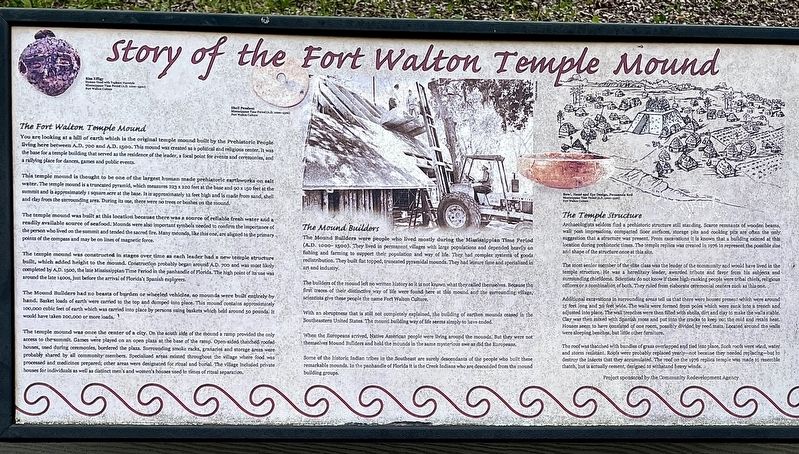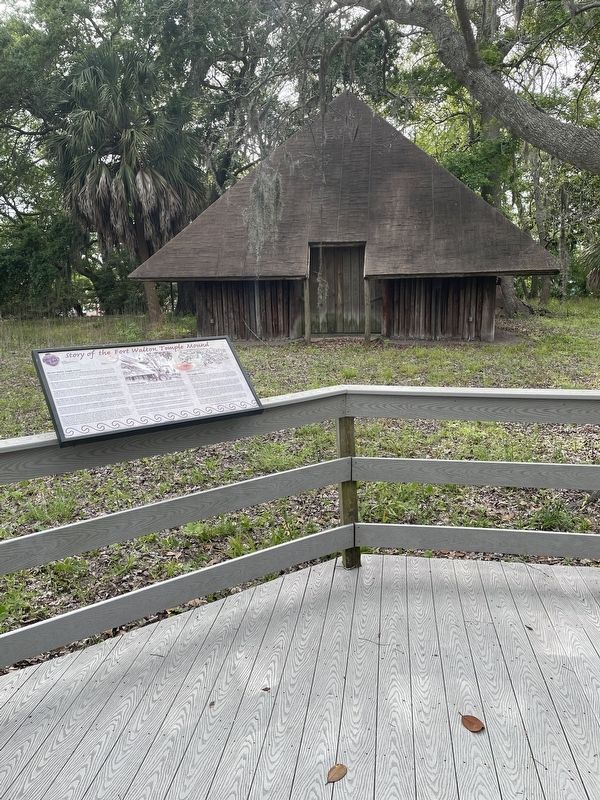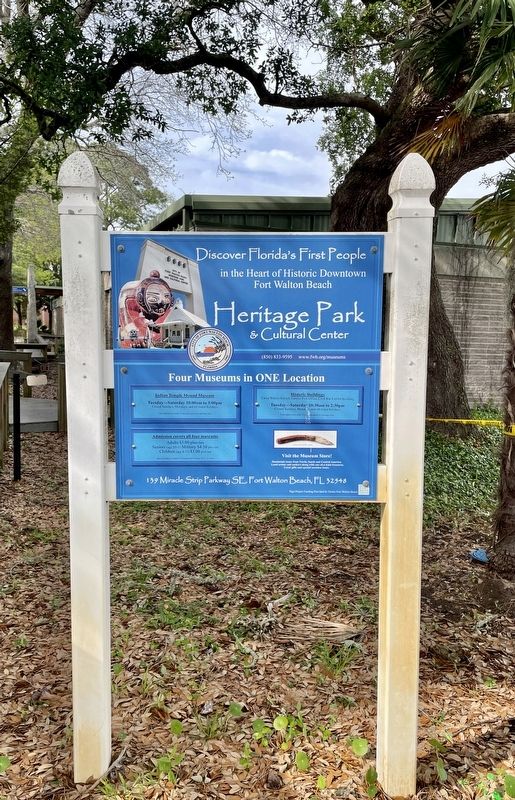Fort Walton Beach in Okaloosa County, Florida — The American South (South Atlantic)
Story of the Fort Walton Temple Mound
— Indian Temple Mound and Museum and the Heritage Park and Cultural Center —
The Fort Walton Temple Mound
You are looking at a hill of earth which is the original temple mound built by the Prehistoric People living here between A.D. 700 and A.D. 1500. This mound was created as a political and religious center. It was the base for a temple building that served as the residence of the leader, a focal point for events and ceremonies, and a rallying place for dances, games and public events.
This temple mound is thought to be one of the largest human made prehistoric earthworks on salt water. The temple mound is a truncated pyramid, which measures 223 x 220 feet at the base and 90 x 150 feet at the summit and is approximately 1 square acre at the base. It is approximately 12 feet high and is made from sand, shell and clay from the surrounding area. During its use, there were no trees or bushes on the mound.
The temple mound was built at this location because there was a source of reliable fresh water and a readily available source of seafood. Mounds were also important symbols needed to confirm the importance of the person who lived on the summit and tended the sacred fire. Many mounds, like this one, are aligned to the primary points of the compass and may be on lines of magnetic force.
The temple mound was constructed in stages over time as each leader had a new temple structure built, which added height to the mound. Construction probably began around A.D. 700 and was most likely completed by A.D. 1500, the late Mississippian Time Period in the panhandle of Florida. The high point of its use was around the late 1400s, just before the arrival of Florida's Spanish explorers.
The Mound Builders had no beasts of burden or wheeled vehicles, so mounds were built entirely by hand. Basket loads of earth were carried to the top and dumped into place. This mound contains approximately 100,000 cubic feet of earth which was carried into place by persons using baskets which held around 50 pounds. it would have taken 200.000 or more loads.
The temple mound was once the center of a city. On the south side of the mound a ramp provided the only access to the summit. Games were played on an open plaza at the base of the ramp. Open-sided thatched roofed houses, used during ceremonies, bordered the plaza. Surrounding smoke racks, granaries and storage areas were probably shared by all community members. Specialized areas existed throughout the village where food was processed and medicines prepared; other areas were designated for ritual and burial. The village included private houses for individuals as well as distinct men's and women's houses used in times of ritual separation.
The Mound Builders
The Mound Builders were people who lived mostly during the Mississippian Time Period (AD. 1000- 1500). They lived in permanent villages with large populations and depended heavily on fishing and farming to support their population and way of life. They had complex systems of goods redistribution. They built flat topped, truncated pyramidal mounds. They had leisure time and specialized in art and industry.
The builders of the mound left no written history so it is not known what they called themselves. Because the first traces of their distinctive way of life were found here at this mound and the surrounding village, scientists give these people the name Fort Walton Culture.
With an abruptness that is still not completely explained, the building of earthen mounds ceased in the Southeastern United States. The mound building way of life seems simply to have ended.
When the Europeans arrived, Native American people were living around the mounds. But they were not themselves Mound Builders and held the mounds in the same mysterious awe as did the Europeans.
Some of the historic Indian tribes in the Southeast are surely descendants of the people who built these remarkable mounds. In the panhandle of Florida it is the Creek Indians who are descended from the mound building groups.
The Temple Structure
Archaeologists seldom find a prehistoric structure still standing. Scarce remnants of wooden beams, wall post impressions, compacted floor surfaces, storage pits and cooking pits are often the only suggestion that a structure was present. From excavations it is known that a building existed at this location during prehistoric times. The temple replica was created in 1976 to represent the possible size and shape of the structure once at this site.
The most senior member of the elite class was the leader of the community and would have lived in the temple structure. He was a hereditary leader, awarded tribute and favor from his subjects and surrounding chiefdoms. Scientists do not know if these high-ranking people were tribal chiefs, religious officers or a combination of both. They ruled from elaborate ceremonial centers such as this one.
Additional excavations in surrounding areas tell us that there were houses present which were around 15 feet long and 30 feet wide. The walls were formed from poles which were sunk into a trench and adjusted into place. The wall trenches were then filled with shells, dirt and clay to make the walls stable. Clay was then mixed with Spanish moss and put into the cracks to keep out the cold and retain heat. Houses seem to have consisted of one room, possibly divided by reed mats. Located around the walls were sleeping benches, but little other furniture.
The roof was thatched with bundles of grass overlapped and tied into place. Such roofs were wind, water and storm resistant. Roofs were probably replaced yearly - not because they needed replacing - but to destroy the insects that they accumulated. The roof on the 1976 replica temple was made to resemble thatch, but is actually cement, designed to withstand heavy winds.
(Captions)
Rim Effigy
Human Head with Typical Hairstyle
Mississippian Time Period (A.D. 1000 - 1500 )
Fort Walton Culture
Shell Pendant
Mississippian Time Period (A.D. 1000 - 1500 )
Fort Walton Culture
Bowl, Head and Eye Design, Pensacola Red
Mississippian Time Period
(A.D. 1000 - 1500)
Fort Walton Culture
Erected by The Community Redevelopment Committee.
Topics. This historical marker is listed in these topic lists: Anthropology & Archaeology • Cemeteries & Burial Sites • Native Americans. A significant historical year for this entry is 700 CE.
Location. 30° 24.253′ N, 86° 36.426′ W. Marker is in Fort Walton Beach, Florida, in Okaloosa County. Marker can be reached from Miracle Strip Parkway Southeast (U.S. 98) west of Florida Place, on the right when traveling west. Marker is located at the Indian Temple Mound Museum in the City of Fort Walton Beach Heritage Park and Cultural Center. Touch for map. Marker is at or near this postal address: 139 Miracle Strip Pkwy SE, Fort Walton Beach FL 32548, United States of America. Touch for directions.
Other nearby markers. At least 8 other markers are within walking distance of this marker. Preserving and Protecting the Mound (here, next to this marker); a different marker also named Preserving and Protecting the Mound (a few steps from this marker); a different marker also named Story of the Fort Walton Temple Mound (a few steps from this marker); Fort Walton (within shouting distance of this marker); Okaloosa County Desert Storm Memorial (within shouting distance of this marker); Gulfview Hotel (about 400 feet away, measured in a direct line); Indianola Inn, An Indian Midden Mound, and Civil War Cannons (about 700 feet away); Bud & Dorie Day Patriots' Trail (approx. 0.8 miles away). Touch for a list and map of all markers in Fort Walton Beach.
Also see . . . Heritage Park & Cultural Center. Fort Walton Beach website entry: (Submitted on April 30, 2023, by Brandon D Cross of Flagler Beach, Florida.)
Credits. This page was last revised on October 31, 2023. It was originally submitted on April 30, 2023, by Brandon D Cross of Flagler Beach, Florida. This page has been viewed 54 times since then and 11 times this year. Photos: 1, 2, 3. submitted on April 30, 2023, by Brandon D Cross of Flagler Beach, Florida. • Bernard Fisher was the editor who published this page.


